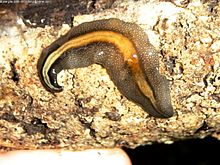| Geoplanidae | |
|---|---|

| |
| Obama burmeisteri from the Atlantic rainforests of southern Brazil | |
| Scientific classification | |
| Domain: | Eukaryota |
| Kingdom: | Animalia |
| Phylum: | Platyhelminthes |
| Order: | Tricladida |
| Superfamily: | Geoplanoidea |
| Family: | Geoplanidae Stimpson, 1857 |
| Subfamilies[1] | |
|
See text | |
| Synonyms | |
| |
Geoplanidae is a family of flatworms known commonly as land planarians or land flatworms.[2]
These flatworms are mainly predators of other invertebrates, which they hunt, attack and capture using physical force and the adhesive and digestive properties of their mucus.[3] They lack water-retaining mechanisms and are therefore very sensitive to humidity variations of their environment.[4]
Because of their strict ecological requirements, some species have been proposed as indicators of the conservation state of their habitats.[4][5] They are generally animals with low vagility (dispersal ability) and with very specific habitat requirements, so they can be also used to accurately determine the distribution of biogeographic realms. Today the fauna of these animals is being studied to select conservation priorities in the Atlantic rainforest in Brazil.[6]
At the other extreme, one species in this family, Platydemus manokwari has become an invasive species in both disturbed and wild habitats in the Pacific Islands, and has damaged the endemic land snail fauna. This species has been found in Europe (France) in 2013 for the first time,[7] and in 2015 in New Caledonia, Wallis and Futuna Islands, Singapore, Solomon Islands, Puerto Rico (first record in the Caribbean), and Florida, USA.[8]
- ^ Sluys, R.; Kawakatsu, M.; Riutort, M.; Baguñà, J. (2009). "A new higher classification of planarian flatworms (Platyhelminthes, Tricladida)". Journal of Natural History. 43 (29–30): 1763–1777. doi:10.1080/00222930902741669. S2CID 85174457.
- ^ Winsor, L.; Johns, P. M.; Yeates, G. M. (1998). "Introduction, and ecological and systematic background, to the Terricola (Tricladida)". Pedobiologia. 42 (5–6): 389–404. doi:10.1016/S0031-4056(24)00461-X.
- ^ Ogren, R. E. (1995). "Predation behaviour of land planarians". Hydrobiologia. 305 (1–3): 105–111. doi:10.1007/BF00036370. S2CID 31413150.
- ^ a b Sluys, R. (1999). "Global diversity of land planarians (Platyhelminthes, Tricladida, Terricola): a new indicator-taxon in biodiversity and conservation studies". Biodiversity and Conservation. 8 (12): 1663–1681. doi:10.1023/A:1008994925673. S2CID 38784755.
- ^ Carbayo, F.; Leal-Zanchet, A. M.; Vieira, E. M. (2002). "Terrestrial flatworm (Platyhelminthes: Tricladida: Terricola) diversity versus man-induced disturbance in an ombrophilous forest in southern Brazil". Biodiversity and Conservation. 11 (6): 1091–1104. doi:10.1023/A:1015865005604. S2CID 5912963.
- ^ Álvarez-Presas, M.; Sánchez-Garcia, A.; Carbayo, F.; Rozas, J.; Riutort, M. (2014). "Insights into the origin and distribution of biodiversity in the Brazilian Atlantic forest hot spot: a statistical phylogeographic study using a low-dispersal organism". Heredity. 112 (6): 656–665. doi:10.1038/hdy.2014.3. PMC 4023448. PMID 24549112.
- ^ Justine, Jean-Lou; Winsor, Leigh; Gey, Delphine; Gros, Pierre; Thévenot, Jessica (2014). "The invasive New Guinea flatworm Platydemus manokwari in France, the first record for Europe: time for action is now". PeerJ. 2: e297. doi:10.7717/peerj.297. PMC 3961122. PMID 24688873.

- ^ Justine, Jean-Lou; Winsor, Leigh; Barrière, Patrick; Fanai, Crispus; Gey, Delphine; Han, Andrew Wee Kien; La Quay-Velázquez, Giomara; Lee, Benjamin Paul Yi-Hann; Lefevre, Jean-Marc; Meyer, Jean-Yves; Philippart, David; Robinson, David G.; Thévenot, Jessica; Tsatsia, Francis (2015). "The invasive land planarian Platydemus manokwari (Platyhelminthes, Geoplanidae): records from six new localities, including the first in the USA". PeerJ. 3: e1037. doi:10.7717/peerj.1037. ISSN 2167-8359. PMC 4485254. PMID 26131377.
